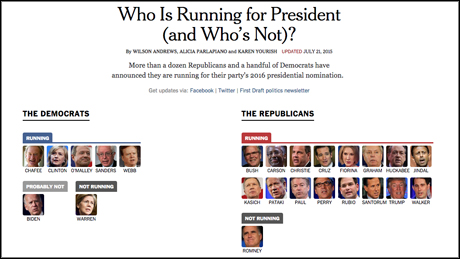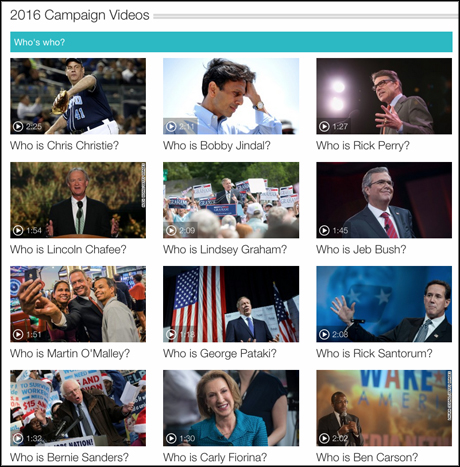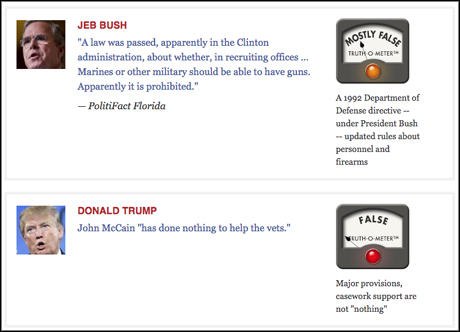
There's still a long way to go until the next United States presidential election, scheduled for November 8, 2016.
For the media industry, though, the political race has already started to heat up: news websites and not-for-profit news organizations are launching ad hoc sections enriched with interesting (and sometimes interactive) features; curated news feeds; mobile apps; newsletters and datasets, all focussing on the DEM versus GOP duel that will mark the end of the Obama era.
Here at Journalism.co.uk we have tried to gather some of the most interesting examples available so far.
Resources and basic information on candidates and primary dates

Screenshot from the New York Times's election interactive
BallotPedia is a nonprofit and nonpartisan collaborative Wikipedia-style website "designed to connect people to politics"; a Bible for everyone looking for fact-checked information about the upcoming election. The project, launched by the Lucy Burns Institute, shows each candidates’ profile and their stances on different policies, from LGBT rights to the Iran nuclear deal. An infographic with the timeline of their announcements is also featured, as well as an interactive map that gathers state-by-state datasets about the elections.
The New York Times launched a section about the 2016 elections featuring a very well-designed interactive listing of the candidates, their essential political traits and what every one of them would need to win. The primary calendar, instead, gives the opportunity to stay updated on caucus dates, today still uncertain in more than a dozen states. Tip: the agenda can also be imported (with one click) into Google Calendar or iCal/Outlook.
The latest updates and news on the elections

Screenshot from CNN's campaign video collection
When it comes to news on the elections, the only risk is to be spoiled for choice. Most news organizations have already set up dedicated pages for the big 2016 event, each with unique strong points: CNN has very good videos; POLITICO features rich analysis and frequent updates, The New York Times highlights the most important pieces of information at a glance, day after day. BallotPedia, mentioned above, has a feed of recent articles automatically generated with a Google News search for the terms '2016, presidential, election'.
Do you prefer to get the news directly in your inbox? The 2016 Blast is POLITICO’s daily newsletter about the latest coverage on the presidential run, with scoops, leaks, ins and outs. Also, the New York Times' First Draft and Real Clear Politics' newsletters are great ways to stay updated on the race for the nation’s highest executive office without missing a single beat.
If you’re eager for tweets, don’t panic: POLITICO has started a Twitter account focused on election news.
Polls, projections, results

Screenshot from HuffPo's Pollster
Aggregating data from the latest opinion polls, The Huffington Post Pollster offers a number of constantly updated charts showing estimates on various perspectives of the 2016 race: the primaries, the caucuses, the Clinton versus Bush challenge. The charts, which get revised whenever new polls are released, are completely customizable and could be embedded in any website.
For a more complete overview on how American public opinion is changing over time, Real Clear Politics sorts all the polls chronologically in one page. RCP also has a newsletter dedicated to poll alerts. You can subscribe here.
Need a poll tracker on your mobile device? Frontrunner, a free iOS app, is a great way to follow the 2016 presidential election and get push notifications on new polling results.
The iPad-only app 270toWin, however, gives the possibility to create a customized "forecast map" for the 2016 election and access to a variety of resources such as state voting history, an interactive timeline, daily news and election facts. It costs $0.99, or £0.69.
Fact-checked information and focused research

Screenshot from Politifact.com
Clinton, Trump, Cruz, Bush: who will get through the Pinocchio Test? The Washington Post’s Fact Checker has already started to verify facts and candidates’ declarations with accuracy. And it has a specific category for the election.
The blog, started as a column during the 2008 election and made a permanent feature of the Post since 2011, promises to "increasingly focus" on statements made in the heat of the 2016 presidential contest.
PolitiFact, a Pulitzer-winning project started by The Tampa Bay Times, also fact-checks statements and bids from candidates and highlights their level of sincerity using an indicator named Truth-O-Meter. In the same vein, FactCheck.org has built a dedicated page for the upcoming American elections, updated almost daily.
In a ballot that could see the first female president elected to the White House, Presidential Gender Watch is a must-visit website that tracks and analyses gender dynamics during the 2016 race.
Launched by the Center for American Women and Politics and the Barbara Lee Family Foundation, the project aims to "further public understanding of how gender influences candidate strategy, voter engagement and expectations, media coverage, and electoral outcomes".
What’s next? Snapchat
The 2008 ballot was labeled alternatively as the "YouTube election" and the "Facebook election", since the two platforms were heavily used by the staff of Barack Obama to convey his messages and behind-the-scenes snaps of his campaign.
The 2012 election went down in history as the Twitter election, thanks to tweets like the legendary ‘Four more years’. 2016 election will likely see the rise, in addition to all those social platforms, of Instagram, live streaming apps (Hillary Clinton and Ted Cruz used Periscope to broadcast rallies and interviews) and Snapchat.
Snapchat is already used by some of the contenders (Marco Rubio and Jeb Bush, but Hillary might catch up soon) to engage a broader and younger audience. And now, the ephemeral messaging app made clear that it wants to curate content on its own around the presidential election.
After hiring the CNN political reporter Peter Hamby, Snapchat is looking for content analysts that will help it “cover the 2016 presidential race and other news events”. We will see how the project turns out but, by all means, Snapchat aims to be a game changer in communication strategies during the upcoming elections.
Spotted any other features or resources for the 2016 US election your fellow journalists should know about? Let us know in the comments below.
Free daily newsletter
If you like our news and feature articles, you can sign up to receive our free daily (Mon-Fri) email newsletter (mobile friendly).
Related articles
- New resources to help journalists fight elections misinformation
- What did First Draft learn from fact-checking the US 2020 election?
- The Economist launches weekly podcast and newsletter on US election to boost subscriptions
- Jenni Sargent, managing director at First Draft, on language around false claims, reaching sceptical audiences and collaboration
- How News Now Finland is plugging the gap in English language news about the country









